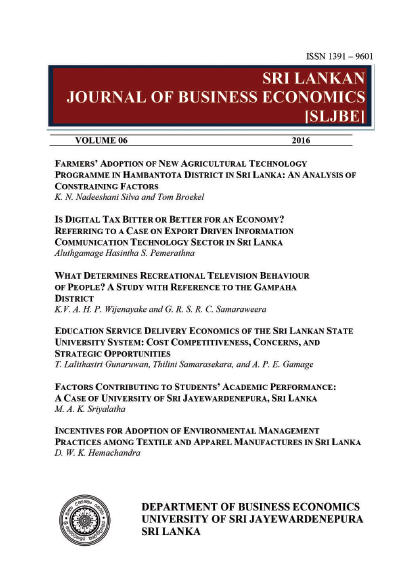WHAT DETERMINES RECREATIONAL TELEVISION BEHAVIOUR OF PEOPLE? A STUDY WITH REFERENCE TO THE GAMPAHA DISTRICT
Abstract
Although the television industry carries great importance in micro and
macroeconomic aspects and supports a great demand as a recreational or
leisure source among people, it seems that the television industry is lagging
behind its actual capacity and is widely contributing to the domestic GDP.
Less effective management and poor identification of choices of people has
driven the industry toward poor conditions. Therefore, this study
contributes to identify the factors that support the television program
preferences of people, selection of public or private channels and time
spent in front of the television. These identifications would indeed help the
television industry to achieve maximum capacity while competing
effectively in an oligopolistic market and achieving higher contribution to
the national GDP.
In order to obtain the statistical analysis, primary data has been gathered
from four Grama Niladari Divisions of the Gampaha Divisional Secretariat
in the Western Province, Sri Lanka. Simple random sampling procedure
has been carried out in the sample selection process and data has been
gathered from 609 individuals in 168 households; from February 2015 to
April 2015, to identify determinants of programme preferences and
public/private channel choices, the binary logistic regression model has
been applied. The semi log regression model is used to identify the
determinants of television watching hours of the people.
Results in the binary logistic model of programme preferences emphasize
that old, male, married and employed individuals are showing more interest
in news and knowledge related programmes while creating positive
significant relationships with the news and knowledge based programme
demand. When a person is being employed, public channels were mostly
preferred creating significant positive relationship while when a person is
having specific political norm, they prefer mostly private channels and
create significant negative relationship in the model. Regarding the hours
allocated for watching television by the people, age, marital status and
employment status shows positive relationships within the model.
Considering the employed segment; when a person has more than 8 hours
of working time, it shows a significant negative relationship with television
watching hours. In descriptive statistics, it shows that old and middle aged
people are more interested in watching news and politics related programmes while females mostly prefer programmes containing softcontent such as tele-dramas and religion based programmes. Considering news preference in separate, Hiru TV was leading among other channels. “Atapattama” on ITN was the most preferred knowledge based programme followed by “Doramadalawa” on ITN. “Satana” programme on Sirasa TV was the mainly preferred political programme among individuals. On the other hand, when it came to tele-dramas, the largely favoured Indian mega dramas were “Me Adarayai” and “Sapna”, telecast by Sirasa TV. “Hiru CountDown” was leading among the respondents when it came to their most preferred musical programmes.
Keywords: Demand for Watching Television, Hours Spent Watching Television, Programme Specific Demand, Public/Private Channel Choices

